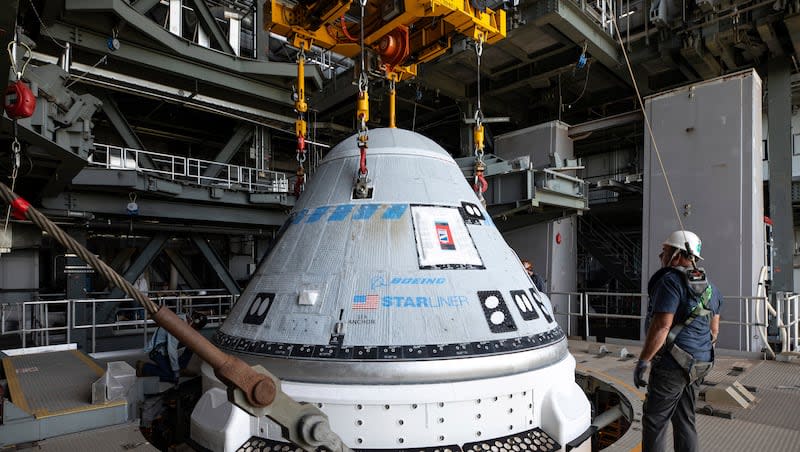Boeing/NASA say helium leak a non-issue, set new Starliner launch date

Boeing and NASA officials say a helium leak, discovered after a May 6 launch attempt for the debut manned flight of Boeing’s Starliner crew capsule was scrubbed due to another issue, isn’t serious enough to warrant further delays and announced June 1 as the next target launch date for a mission to the International Space Station.
At a Friday press conference, Mark Nappi, vice president and manager of Boeing’s Commercial Crew program, said the leak was small and stable and would be monitored throughout the mission.
“We know we can manage this (leak), so this is really not a safety of flight issue,” Nappi said.
The decision follows resolution of another technical glitch discovered just hours before the May 6 launch that required replacement of a valve on the United Launch Alliance Atlas V rocket that will power the Boeing craft to low Earth orbit.
Liftoff is now scheduled for no earlier than 12:25 p.m. EDT on June 1, from Space Launch Complex-41 at Cape Canaveral Space Force Station in Florida.
NASA astronauts Butch Wilmore and Suni Williams, the flight’s commander and pilot, respectively, remain in preflight quarantine at NASA’s Johnson Space Center in Houston, according to NASA. While there, they will continue to conduct various exercises using Starliner simulators ahead of the launch.
Earlier this month, NASA Administrator Bill Nelson said the Starliner test flight is a crucial step in NASA’s ongoing efforts to commercialize the business of space exploration, including the effort to replace the job of ferrying astronauts to the International Space Station following the retirement of the Space Shuttle program in 2011. The SpaceX Dragon crew capsule was the first private enterprise to deliver astronauts to the ISS in 2020.
“This is all a part of our commercial activities,” Nelson said. “You’ve already seen commercial crew and cargo go to orbit with the Dragon and other cargo vehicles. This will give us that additional capacity because we always look for a backup.
“It’s a fixed-price contract. We share in the development costs but then the operation is a fixed-price contract. We’re doing that as we go to the moon as well.”
Starliner’s June 1 launch, should it come to fruition, will mark the first time since 1968′s Apollo 7 mission that a crewed mission will lift off from Cape Canaveral Space Force Station, formerly known as the Cape Canaveral Air Force Station.
The privatization of manned space travel
Back in 2014, NASA announced a pair of “groundbreaking” contracts, granted to Boeing and SpaceX, aiming to bring the job of ferrying astronauts to and from the orbiting International Space Station, a task that was assumed by Russia’s Roscosmos following the retirement of the Space Shuttle program in 2011, back to the U.S.
Boeing’s decades-long partnership with NASA and jumbo $4.2 billion contract, compared to SpaceX’s $2.6 billion, led many to believe early on that the legacy aircraft and aerospace company would outpace Elon Musk’s scrappy space startup and be first to the finish line in NASA’s new Commercial Crew Transportation Capability effort.
But a series of delays allowed SpaceX to leapfrog Boeing in the work to develop a new crew transport vehicle and in 2020, SpaceX’s Dragon 2 Crew Capsule became the first U.S.-launched spaceflight to carry astronauts to the ISS since the final, 13-day shuttle mission performed by Atlantis.
Starliner is expected to dock with the ISS about 26 hours after launch and Wilmore and Williams will spend about a week aboard the station before returning on a mission focused on testing and confirming Starliner’s capabilities.
Utah could play a role in Starliner’s debut crew flight as the U.S. Army’s Dugway Proving Ground in the state’s west desert is among a short list of possible landing sites, which also includes two targets in the vast White Sands Missile Range, New Mexico, and Willcox, Arizona, according to NASA. Edwards Air Force Base in California is available as a contingency landing site.
While a parachute-assisted ground landing is expected, the Starliner capsule is also capable of a water landing.
Boeing’s long journey to space
Boeing has had to overcome issues both within and without its Starliner program on the path to Monday’s scheduled launch, while SpaceX has now completed nine crewed missions to the ISS with its Dragon capsule and has a 10th in progress.
An uncrewed Starliner test flight in 2019 exposed software and communications issues that combined to derail an attempt to dock with the ISS and almost led to the crew ship’s destruction, per CBS News.
A second test flight in 2021 was scrubbed after engineers discovered corroded valves in the spacecraft’s propulsion system, pushing the next attempt to 2022. And while that flight was a success, potential problems with Starliner’s parachute lines were revealed as well as the need to replace about a mile of electrical tape that was found to be flammable.
Along the way, Boeing has had to navigate major issues in its commercial airliner division, including the tragic 737 Max plane crashes and, more recently, production and quality control issues that were highlighted when a Boeing plane flown by Alaska Airlines lost a door plug component in the passenger cabin during a flight.
